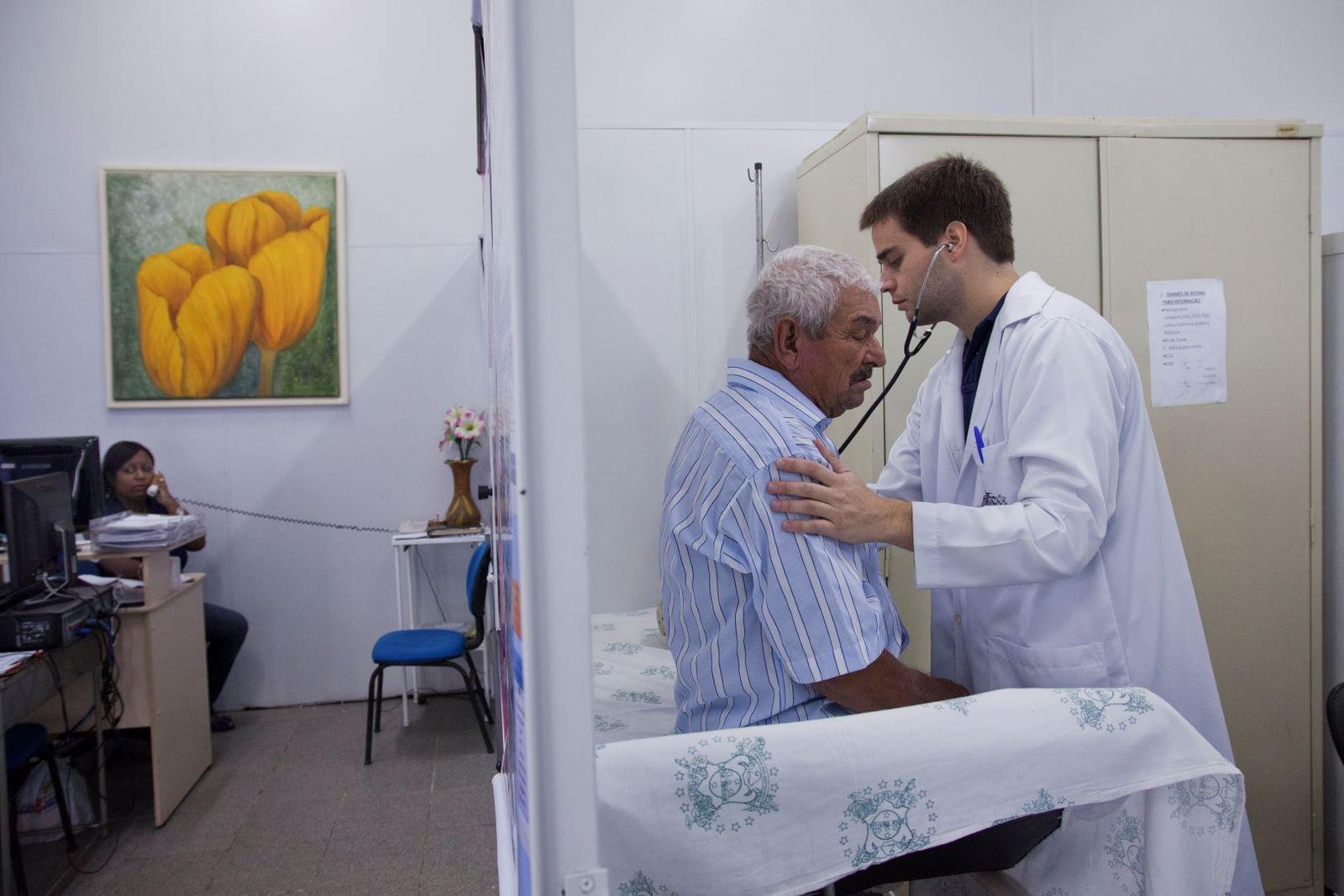Rethinking the Science of COPD

Chronic obstructive pulmonary disease (COPD) is the third most common cause of death worldwide, yet the way we treat people living with this disease has not meaningfully changed in decades.1,2 In partnership with Regeneron, we are working to transform the way COPD is understood and treated, with the goal of bringing relief to millions of people as well as to healthcare systems globally.
Change Cannot Come Quick Enough for COPD Patients
Chronic obstructive pulmonary disease (COPD) is a life-threatening respiratory disease that damages the lungs and causes progressive lung function decline. Smoking and exposure to toxic particles are key risk factors for developing COPD, but even individuals who have quit smoking can still have progressive disease.3,4 It erodes physical, mental and emotional well-being, making it difficult for patients living with COPD to go about their daily lives.5-9 The stigma associated with smoking can further drive feelings of blame and shame for patients, and negatively impact their care and support they receive from their communities.10
In the world of COPD, preventing symptoms from worsening is everything. Every disease exacerbation (flare-up) can lead to permanent damage to the lungs and can trigger more severe and more frequent flare ups in the future, which contribute to worsening lung function (a main cause for breathlessness) and increased risk of death.11-14
It is a downward spiral for patients and their caregivers, with one out of every three people admitted to the ICU for severe COPD symptoms never coming out, and 50% of patients dying approximately 3.5 years after their first hospital admission due to a disease flare up.15,16
The current standard of care inhaled therapies can help patients manage symptoms but do little to address underlying chronic lung inflammation. Moreover, a significant number of patients with COPD may experience two or more flare ups each year despite optimal standard of care treatment.16 Patients worsen over time with progressive lung function decline and limited treatment options.17-20

An Increasing Strain on Society
The impact of COPD extends far beyond the patient, affecting healthcare systems and broader communities:
- The direct cost of COPD care is nearly €40 billion per year in the EU.3
- In the U.S., the total economic cost of COPD is nearly $50 billion per year, including direct healthcare costs and indirect morbidity and mortality impacts.21
- As COPD progresses, there is increased healthcare utilization, growing the economic and emotional toll of the disease.3,22-25
Transforming the COPD Paradigm
The complex, heterogeneous underlying biology of COPD has posed significant challenges for innovating new treatments. People living with COPD need a more targeted approach to treatment that addresses underlying causes of disease progression to reduce the risk of flare-ups, preserve lung function and improve quality of life.
Supported by mounting evidence, we’ve made significant investments into exploring new ways to treat COPD. Our approach is focused on targeting different types of chronic inflammation that we believe are driving disease progression. We are targeting different processes within the body’s chain of inflammatory responses, known as the inflammatory cascade. This includes targeting proteins called interleukins, with some that are involved in the type 2 inflammatory pathway like interleukin 4 and interleukin 13 (IL-4 and IL-13), as well as interleukin 33 (IL-33), which initiates and amplifies multiple inflammatory responses in COPD.20
We believe that disrupting some of these harmful processes with biologic medicines could prevent progressive airflow obstruction, airway remodeling and lung tissue destruction, which leads to flare-ups and a decline in lung function. And by examining different points in the inflammatory cascade, we are increasing our chances of treating many different patients with this heterogeneous disease.
Removing Barriers for Patients
What we are trying to achieve in COPD is no small feat, but it’s a worthy pursuit.
As we expand scientific advancement in COPD, we must also work with fellow industry stakeholders, healthcare professionals, patient associations and policy makers to remove barriers to COPD treatment. We are putting a stake in the ground for COPD care by ensuring our continued commitment to the COPD community, raising awareness about the underlying cause of COPD and its heterogeneity, and working with key stakeholders to ensure better health outcomes for patients and their families.
Patients and caregivers need our help, and we are ready to rise to the occasion to transform outcomes in COPD.
Find out more about immunology and inflammation research

We're On Track to Lead in Immunoscience

Taking Down Type 2 Inflammatory Disease

Immunology and Inflammation R&D
References
- World Health Organization (2020). The top 10 causes of death. Accessed 26 April 2022
- World Health Organization (2023). Chronic obstructive pulmonary disease (COPD). Accessed 26 April 2022
- The Global Initiative for Chronic Obstructive Lung Disease (2023). Global Strategy For The Diagnosis, Management, And Prevention Of Chronic Obstructive Pulmonary Disease (2023 Report). Accessed 26 April 2022
- Linden D, Guo-Parke H, Coyle PV, et al. (2019) Respiratory viral infection: a potential "missing link" in the pathogenesis of COPD. Eur Respir Rev 28(151):180063; DOI: 10.1183/16000617.0063-2018
- Seemungal TA, Donaldson GC, Paul EA, et al. (1998) Effect of exacerbation on quality of life in patients with chronic obstructive pulmonary disease. Am J Respir Crit Care Med 157:1418-1422; DOI: 10.1164/ajrccm.157.5.9709032
- Jones PW, Brusselle G, Dal Negro RW, et al. (2012) Patient-centered assessment of COPD in primary care: experience from a cross-sectional study of health-related quality of life in Europe. Prim Care Respir J 21(3):329-336; DOI: 10.4104/pcrj.2012.00065
- Meguro M, Barley EA, Spencer S, et al. (2007) Development and Validation of an Improved, COPD-Specific Version of the St. George Respiratory Questionnaire. Chest 132(2):456-463; DOI: 10.1378/chest.06-0702
- Miravitlles M and Anna Ribera. (2017) Understanding the impact of symptoms on the burden of COPD. Respir Res 18(1):67; DOI: 10.1186/s12931-017-0548-3
- Machado A, Marques A, Burtin C. (2021) Extra-pulmonary manifestations of COPD and the role of pulmonary rehabilitation: a symptom-centered approach. Expert Rev Respir Med 15(1):131-142; DOI: 10.1080/17476348.2021.1854737
- Mathiousdakis AG, Ananth S, Vestbo J. (2021) Stigma: an unmet public health priority in COPD. The Lancet 9(9): 955-956; DOI: 10.1016/s2213-2600(21)00316-7
- Suissa S, Dell’Aniello S, Ernst P. (2012) Long-term natural history of chronic obstructive pulmonary disease: severe exacerbations and mortality. Thorax 67(11):957-963; DOI: 10.1136/thoraxjnl-2011-201518
- Garcia-Aymerich J, Serra Pons I, Mannino DM, et al. (2011) Lung function impairment, COPD hospitalisations and subsequent mortality. Thorax 66(7):585-590; DOI: 10.1136/thx.2010.152876
- Hansel TT and Peter J Barnes. (2009) New drugs for exacerbations of chronic obstructive pulmonary disease. The Lancet 374(9691):744-755; DOI: 10.1016/s0140-6736(09)61342-8
- Donaldson GC, Seemungal TA, Bhowmik A, et al. (2002) Relationship between exacerbation frequency and lung function decline in chronic obstructive pulmonary disease. Thorax 57(10):847-852; DOI: 10.1136/thorax.57.10.847
- Singanayagam A, Schembri S, Chalmers JD. (2013) Predictors of mortality in hospitalized adults with acute exacerbation of chronic obstructive. Ann Am Thorac Soc 10(2):81-89; DOI: 10.1513/annalsats.201208-043oc
- Halpin DMG, Dransfield MT, Han MK, et al. (2020) The effect of exacerbation history on outcomes in the IMPACT trial. Eur Respir J 55(5)7:1901921; DOI: 10.1183/13993003.51921-2019
- Lams BEA, Sousa AR, Rees PJ, et al. (2000) Subepithelial immunopathology of the large airways in smokers with and without chronic obstructive pulmonary disease. Eur Respir J 15(3):512–516; DOI: 10.1034/j.1399-3003.2000.15.14.x
- Balzano G, Stefanelli F, Iorio C, et al. (1999) Eosinophilic inflammation in stable chronic obstructive pulmonary disease. Am J Respir Crit Care Med 160(5):1486–1492; DOI: 10.1164/ajrccm.160.5.9810105
- Lee H, Um SJ, Kim YS, et al. (2016) Association of the neutrophil-to-lymphocyte ratio with lung function and exacerbations in patients with chronic obstructive pulmonary disease. PLoS One 11(6):e0156511; DOI: 10.1371/journal.pone.0156511
- Peter J. Barnes. (2019) Inflammatory endotypes in COPD. Allergy 74(7):1249–1256; DOI: 10.1111/all.13760
- American Lung Association (2023). COPD Trends Brief: Burden. Accessed 26 April 2022
- Guarascio AJ, Ray SM, Finch CK, et al. (2013) The clinical and economic burden of chronic obstructive pulmonary disease in the USA. Clinicoecon Outcomes Res 5:235-245; DOI: 10.2147/ceor.s34321
- Kim C, Kim Y, Yang DW, et al. (2019) Direct and Indirect Costs of Chronic Obstructive Pulmonary Disease in Korea. Tuberc Respir Dis (Seoul) 82(1):27-34; DOI: 10.4046/trd.2018.0035
- GBD Chronic Respiratory Disease Collaborators. (2020) Prevalence and attributable health burden of chronic respiratory diseases, 1990–2017: a systematic analysis for the Global Burden of Disease Study 2017. The Lancet Respir Med 8(6):585-596; DOI: 10.1016/s2213-2600(20)30105-3
- GBD 2019 Diseases and Injuries Collaborators. (2019) Global burden of 369 diseases and injuries in 204 countries and territories, 1990-2019: a systematic analysis for the Global Burden of Disease Study 2019. The Lancet 396(10258):1204-1222; DOI: 10.1016/s0140-6736(20)30925-9